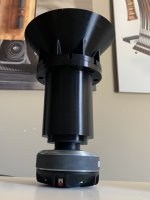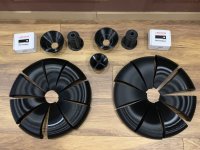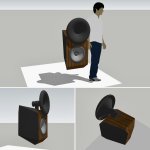Generally 4 times the excursion per octave to keep a set SPL. So yes I agree that you cannot simulate these things. I design drivers and I can tell you that this really cannot be accurately simulated. The desk engineers believe that they can. But when you are actually making drivers in the real world it is not the same as computer land.The problem is not that it couldn't be simulated, but that seldom you have all the input data at hand.
But even if the required excursion was reliably known, what does it tell about the capabilities of a particular driver? What portion of its available excursion we can use without audible issues?
As we move lower in frequency, there is typically a sharp onset of the required excursion to keep a constant SPL, like in the simulation example below of an extended throat, including a simple CD model.
View attachment 1336981
I think that this will also be the frequency below which the distortion will just ramp up quickly. That's probably to fastest way how to get this information - to measure the harmonic distortion.
In other words test your drivers well under the conditions that you are hoping to use them. The horns will aid the reproduction and should lower excursion over their operating bandwidth, but a junk driver is not going to turn into a great driver.I think that until we know the audible relation to measurement data in detail, the only thing we can do is to attack the issue as engineers and just remove as much non wanted artefacts as possible in order to achieve an as clean signal as possible from the aspects we know: level SPL, level vs. frequency, any order harmonic distortion level, level of non harmonic energy addition, phase linearity, dispersion and all this as a function of time.
B&C DH450 are orderable from TLHP, my pair is on its way. I'm especially curious how well it will respond to an extended throat, as it seems that it has basically a cylindrical exit, or sort of.
I got all the prints and drivers here but it seems I actually do need the flange as the extension tube does not have a flange to connect the driver to. So which flange from the package I should print next?The three jigs are for different print tolerance clearances - the "JIG-1" is exact, the "OFF-Xmm" has the face offseted a fraction of mm. You can try the exact one.
There are no separate flanges with G2. You have already all you need.
Attachments
The flange is made of two STL files, T520-25-EXT-1-flange1.stl and T520-25-EXT-1-flange1.stl, both included in the adapter package you already have, as I understand. It's not clear to me why you don't have those printed as well.

BTW, in the meantime, there's also a matched adapter for the DF10.171K as well. You may be better off with that one.
BTW, in the meantime, there's also a matched adapter for the DF10.171K as well. You may be better off with that one.
It is a misunderstanding. When you said you have everything you need in g2 and you do not need the flange, I understood wrongly 🙂 I will print them now.
My first measurement of the DH450 with A520G2:


It definitely sounds promising (just like about any other compression driver out there 🙂).
- Take this still as rather preliminary, I was impatient and quickly put it together...
(Again, the SPL axis is not calibrated. It's actually very sensitive for its size. This will a tough competitor overall.)
It definitely sounds promising (just like about any other compression driver out there 🙂).
- Take this still as rather preliminary, I was impatient and quickly put it together...
(Again, the SPL axis is not calibrated. It's actually very sensitive for its size. This will a tough competitor overall.)
Last edited:
Is that the raw measured response?
I assume that there's no compensation and if that's the case it looks to be a really nice combo for simple passive crossover implementation.
I assume that there's no compensation and if that's the case it looks to be a really nice combo for simple passive crossover implementation.
Yes, raw responses, no further processing. We have seen a similar response from the Lavoce driver, which is even smoother and more extended (probably not nearly as sensitive, but I haven't checked yet at absolute levels):
Lavoce DF10.171K

B&C DH450

Both sound very nice, at about the same price. The very high frequencies from the DH450 sound particularly "relaxed", maybe because half of the annoying top octave is missing 🙂
I believe that for a PA use, the DH450 will have an edge. For home reproduction, I'm not sure. I could definitely listen to both, if I was able to tell the different at all, not knowing which is which. All these drivers are really far more similar than different.
Lavoce DF10.171K
B&C DH450
Both sound very nice, at about the same price. The very high frequencies from the DH450 sound particularly "relaxed", maybe because half of the annoying top octave is missing 🙂
I believe that for a PA use, the DH450 will have an edge. For home reproduction, I'm not sure. I could definitely listen to both, if I was able to tell the different at all, not knowing which is which. All these drivers are really far more similar than different.
Last edited:
That looks very promising!
What would be the most useful configurations with midrange drivers?
Midranges should have an equal dispersion at crossover frequency for overall horizontal dispersion... But regarding the diameter of the Horn and the resulting center to center distance - what about vertical dispersion?
What would be the most useful configurations with midrange drivers?
Midranges should have an equal dispersion at crossover frequency for overall horizontal dispersion... But regarding the diameter of the Horn and the resulting center to center distance - what about vertical dispersion?
You need to consider also the wavelength at the crossover frequency, which is correspondingly larger. It's no different (or worse) than any other loudspeaker with noncoincident drivers. It's the crossover design that must deal with this.
Right. With such a perfected waveguide we want to be better than any other loudspeaker ;-)
Asuming 900 Hz xo and a 8" mid driver, wavelength is just in the region of distance of centers (380 mm).
Maybe a symmetrical MTM configuration with (small) mid drivers would be nice.
Asuming 900 Hz xo and a 8" mid driver, wavelength is just in the region of distance of centers (380 mm).
Maybe a symmetrical MTM configuration with (small) mid drivers would be nice.
No, don't do that, that doesn't help anything...Maybe a symmetrical MTM configuration with (small) mid drivers would be nice.
15" woofer, or maybe 12", and ~700 Hz crossover seems like a natural first choice. With the extended throats it's possible to go even lower, as there are no "group delay issues" (i.e. mouth reflections).
Last edited:
I have a preliminary design where I plan on crossing to a 15" woofer (AE SBP15) with a 600hz crossover but the measurements will dictate the results. So first things first, put the horn together and measure!
I am still sanding the individual parts. I will then glue them together, use fillers, sand again, then primer and paint.
I am still sanding the individual parts. I will then glue them together, use fillers, sand again, then primer and paint.
Attachments
At least for myself, it would be interesting to see SPL, Impedance and phase on the same graph. That will let us look and see if there are internal resonances or structural resonances in the driver diaphragm. The other way is a CSD plot. A CSD can actually tell you a lot about how the driver and horn will really behave itself.Yes, raw responses, no further processing. We have seen a similar response from the Lavoce driver, which is even smoother and more extended (probably not nearly as sensitive, but I haven't checked yet at absolute levels):
Lavoce DF10.171K
View attachment 1339439
B&C DH450
View attachment 1339440
Both sound very nice, at about the same price. The very high frequencies from the DH450 sound particularly "relaxed", maybe because half of the annoying top octave is missing 🙂
I believe that for a PA use, the DH450 will have an edge. For home reproduction, I'm not sure. I could definitely listen to both, if I was able to tell the different at all, not knowing which is which. All these drivers are really far more similar than different.
It is all minimum phase. Especially below ~5 kHz it's just a matter of a simple EQ and for the same amplitude target everything else will be the same as well (time response, phase, group delay, CSD, name it). Any kind of nonsmoothness above ~5 kHz is always the driver, virtually always a resonance. Not necessarily the diaphragm only, as there's a lot more going on in a compression driver, but I doubt that the exact cause can be determined from a far-field frequency response.
- I can later upload some raw impulse responses to see what others can get from it.
- I can later upload some raw impulse responses to see what others can get from it.
Last edited:
You know how to make it easy 🙂I have a preliminary design [...]
- So, there will be some stand, not shown?
Yes, there will be. I am working on some designs, I do not want a heavy and bulky looking stand but I want it to fulfill its purpose too.You know how to make it easy 🙂
- So, there will be some stand, not shown?
The box may also be subject to changes however this would be the overall look. It is around 125lt and it models nicely in winisd. It will have a hypex 501 for the bass part, so it will have a dsp. The top will be a simple passive filter and some parallel impedance correction.
- Home
- Loudspeakers
- Multi-Way
- Acoustic Horn Design – The Easy Way (Ath4)


